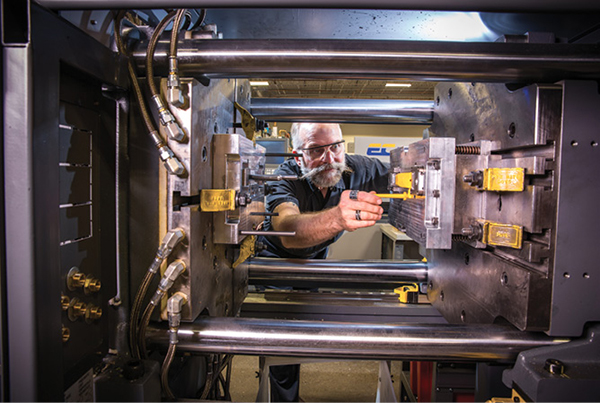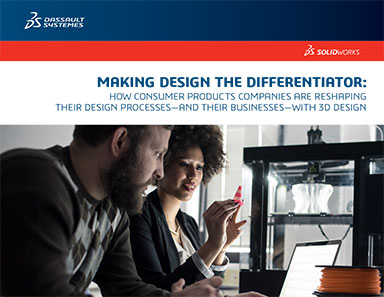The Case for Engineering Outsourcing
Bringing engineering service provider benefits into focus.

Service providers can provide design for manufacturing expertise as well as on-demand manufacturing services. Image courtesy of Protolabs.
Latest in Rapid Prototyping and Manufacturing Services
Rapid Prototyping and Manufacturing Services Resources

Latest News
April 1, 2019
Manufacturers face various new pressures that make it more difficult to remain competitive while they also focus on core competencies. Faced with globalization, varying demand requirements based on omni-channel fulfillment strategies and increased competition for talent, they have turned to outsourcing for a variety of different functions, from marketing to logistics to prototyping.
Engineering tasks are also increasingly farmed out to engineering service providers (ESPs). These firms can provide services such as generating drawings, designing components and full product development. The global engineering services outsourcing market is set to have a compound annual growth rate of more than 27% through 2022, according to HTF Market Intelligence.
Product complexity has driven some of this activity as firms outsource some basic engineering work so that their staff can focus on more complex components. In some cases, internal engineering staff have taken on more complicated tasks like simulation, which has put more demands on their time. In other scenarios, companies are outsourcing the more specialized design work (such as designing for additive manufacturing) because they lack the internal resources.
Manufacturing and design firms may also turn to engineering outsourcing to expand their footprint in new geographies; to update or convert outdated designs and files; or to avoid the hassle and expense of hiring new full- or part-time staffers, or hiring engineers with highly specific skill sets.
“It’s like building a house,” says Jeff Schipper, director of special operations at Protolabs. “Contractors use different subcontractors with different specialties. Those specialists add differentiating value.”
The type of engineering work that gets outsourced varies depending on the application. Companies often contract out product development and design services, which can enable them to bring products to market faster. CAD and drafting are also outsourced frequently, either because the company lacks internal resources to handle those tasks, or because their designers have to delegate some of the grunt work of design while they work on multiple projects. In some cases, companies outsource highly specialized tasks like reverse engineering, which can be time-consuming, or simulation and analysis, which require significant compute resources and expertise.
The automotive industry has used outsourced engineering and design for decades. “In automotive, the suppliers are responsible for proving a product to spec, so it streamlines the design-for-manufacturing feedback loop,” Schipper says. “When you share some of that joint development, it streamlines that upfront process.”
Firms that specialize in outsourced 3D printing, manufacturing or other types of service bureau work also offer third-party engineering services in many cases. Stratasys Direct Manufacturing, for example, provides prototyping and finished parts manufacturing services, but also offers engineering services to support clients who aren’t used to working in the 3D printing space.
“We have a wealth of project and manufacturing engineers to guide customers through those higher requirements,” says Chuck Alexander, director of product management at Stratasys Direct Manufacturing.
In some cases, clients don’t have any familiarity with CAD and other electronic design systems. Stratasys also provides generative design and design-for-additive services, which Alexander says reflects a paradigm shift the company has seen in the industry that goes hand in hand with the adoption of additive manufacturing. Stratasys also provides assistance with material properties and build orientation issues that can come up in design for additive.
“With generative design or topology optimization, you get a lot of organic shapes, and that’s a fairly new thing,” Alexander says. “Engineers may not be trained and focused on that kind of work. We can help them with that. Will that part actually work in production? That’s the type of engineering we’ve added.”
Communication with third-party providers is getting easier thanks to improvements in secure transfer technologies, video conferencing and file transfer protocol. “Now these systems don’t require the insane amount of bandwidth that they used to,” Schipper says. “That just makes communication consistently easier.”
Outsourcing Risks
Outsourcing can have downsides. In the case of additive manufacturing engineering services, service partners may not be up-to-speed on the requirements of the different types of machines and processes. Those introduce some risk. “If someone is not a molding expert but they are making a part that will be molded in production and they’re using 3D printing to accelerate upfront design, then they have to keep the design for the molding process in mind,” Schipper says. “Otherwise they make an unmanufacturable part and have to redesign it later.”
There’s also a risk of losing tribal knowledge as more work is handed down to outside engineers. “There are lessons learned during the design process that have value in future iterations,” Schipper says. “If you make a new version of the same product, and you’ve outsourced part of the design out, you don’t learn those lessons during development. You have to relearn all of those lessons with a new supplier or internally the second time around. When you are working with outside resources, it takes effort to make sure you are gaining that knowledge so it can be applied in the future.”
Handing off engineering work also means that technical expertise has, in effect, been exported to a partner. In some cases, those outsourcing partners may need a significant amount of hand-holding to meet deadlines or quality standards, depending on their level of familiarity with the work they are asked to perform.
According to Alexander, that’s one reason outsourcing has experienced ebbs and flows throughout the past few decades. “We’ve seen cycles where companies pull a lot of things they used to outsource in-house to have control, and then they go back into outsourcing driven by economics.”
Finding the Right Partner
Because of the potential risks involved, it’s important to select a reliable outsourcing services provider. In addition to design and analysis capabilities, companies should look for partners that offer some engineering consulting services that will help with decision-making and documentation.
The selection should be guided by identifying what competencies are required for the project, and then identifying which potential ESPs have those competencies.
Make sure you know what you are looking for and what your own internal capabilities are. Which steps in the design process (concept, design, documentation, analysis, prototyping or production) do you need to outsource, and which can you successfully manage internally?
Evaluate the ESP’s portfolio, and ask for client references who you can speak to directly. The portfolio helps you gauge whether the company’s previous work measures up to your current needs in terms of industry-specific experience and quality. Also, find out which engineers in the company will be working on your project, and vet them based on their education, experience and background.
A technical evaluation is also important. If you have software preferences for CAD, simulation or other functions, make sure they can support those platforms. Do they have enough compute power available to handle the simulations or visualizations you need? Can files easily be transferred back and forth? How will design reviews be handled?
Price is important, but quality and reliability are more critical. Make sure you do a thorough cost analysis to determine the long-term costs of outsourcing versus expanding your own staff.
Once you select a provider, the ESP contract should clearly spell out how responsibilities will be split between the companies, along with detailed specifications, cost and deadline targets, a method for reporting and measuring progress, incentives and consequences for failure to meet those requirements.
All deliverables should be clearly defined and include as much detail as possible. The contract should also include any details related to how communicate and make modifications. Be prepared to jointly conduct feasibility studies to make sure the design will work using the design and production processes spelled out in the contract. Companies should also identify internal staffers who will be responsible for managing the third-party provider’s work, along with quality management, logistics and technical integration.
Outsourcing can be beneficial, but design firms and manufacturers should make sure they approach this strategy with an eye on maintaining control over their design data, intellectual property and their ability to easily update designs later, even if the ESP is no longer a partner. Communication and trust can make a huge difference in the success of outsourcing partnerships.
“You want to work with them strategically, not just transactionally,” Schipper says. “That’s where the big win is over time.”
More Info
More Protolabs Coverage
More Stratasys Coverage
Subscribe to our FREE magazine, FREE email newsletters or both!
Latest News
About the Author
Brian Albright is the editorial director of Digital Engineering. Contact him at [email protected].
Follow DE



